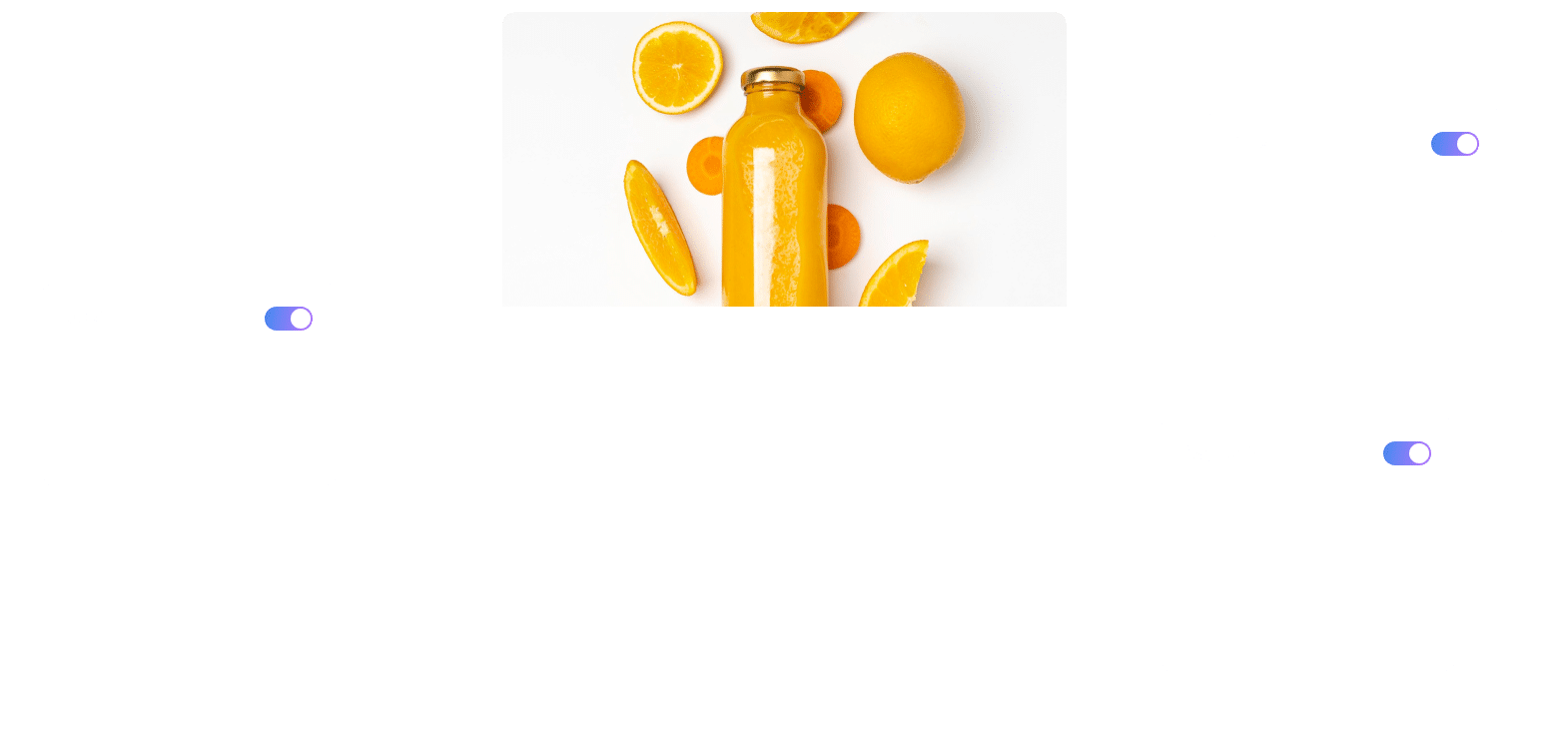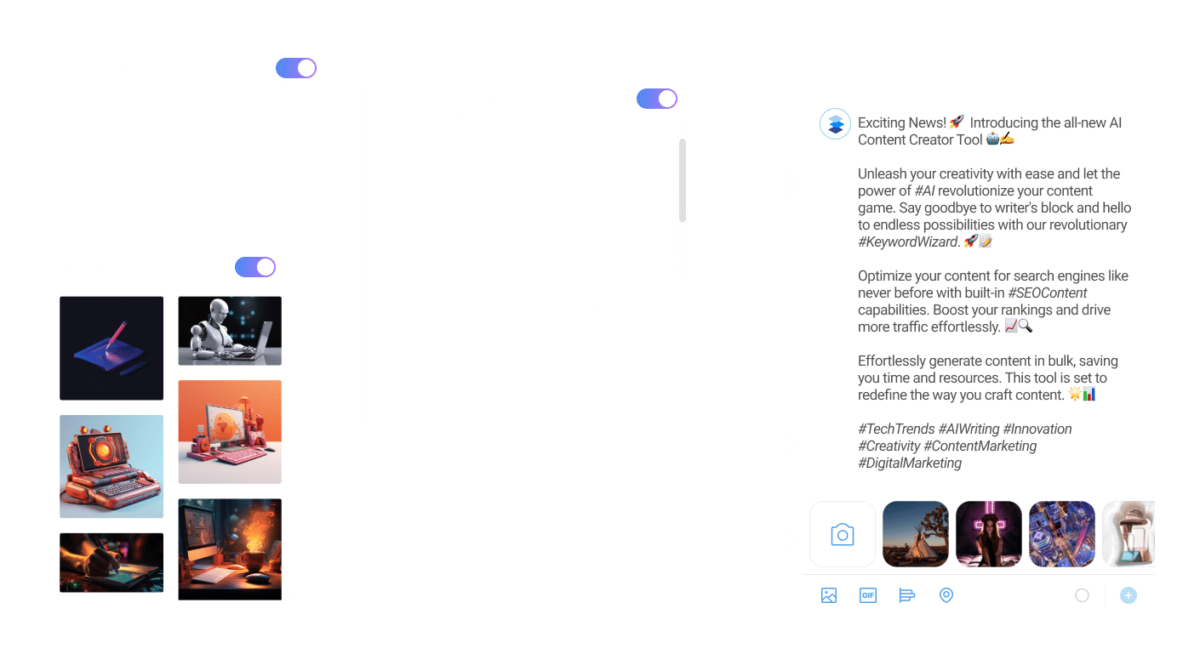Humanlike
Content Creation Platform
Generate content that bypasses AI-Detection
Research your keywords, analyze SERP results and outrank your competition!
🌍 110+ languages!
💳 No card required!
💵 7-day money back guarantee!









SEO compatible templates
⏤ for all your needs.
Integrate ContentGo AI with
your favorite platform!





What our customers say



I highly recommend ContentGo"


Would recommend."

Unique features ⏤
tailored to your success.
Integrations
Connect ContentGo AI with your favorite platform and generate content that ranks at scale!
ContentGo AI helps you manage the content of your platform from its advanced dashboard, where you can create unique content (product descriptions, category descriptions, etc.) and publish them directly.
There is no need to go back and forth all the time!
High-Quality Content
Fluff content is everywhere!
The advanced power mode of ContentGo AI is here to generate high-quality and technical articles for you!
Even if you operate in a niche domain.
Now, you can generate content that really resonates with your audience!
SEO Compatibility
Content is only perfect if it gets the proper attention!
Our unique tool combines a Keyword Wizard with SERP results and does all the magic here.
It enables you to pick the most popular and best-matching keywords and gives you an idea about the top search engine results to help you generate content to outrank your competitors.
Bulk Content
Worried about the upcoming dozens of content that need to be written in no time?
Worry no more! – We got your back 😉
With our super fast and customizable bulk content feature, you can generate multiple content with a single request.
Focus on your other tasks; we’ll notify you once your content is ready!
NEW
AI + Human
💪 Editing
Google loves banning bot content.
Especially after the latest Helpful Content update and the E-E-A-T, you provide valuable insights to your users with each content.
Otherwise, your hard work won’t be rewarded.
This is why we combine AI with Human Intelligence to help you deliver top-notch articles that directly connect with your audience.
Our experienced editors will work on your output and align it perfectly with your brand’s guidelines and your users.
So, your content will give Google a one-way out of ranking it and help you build a loyal audience.
Generate content
⏤ just four step.
Select a Template
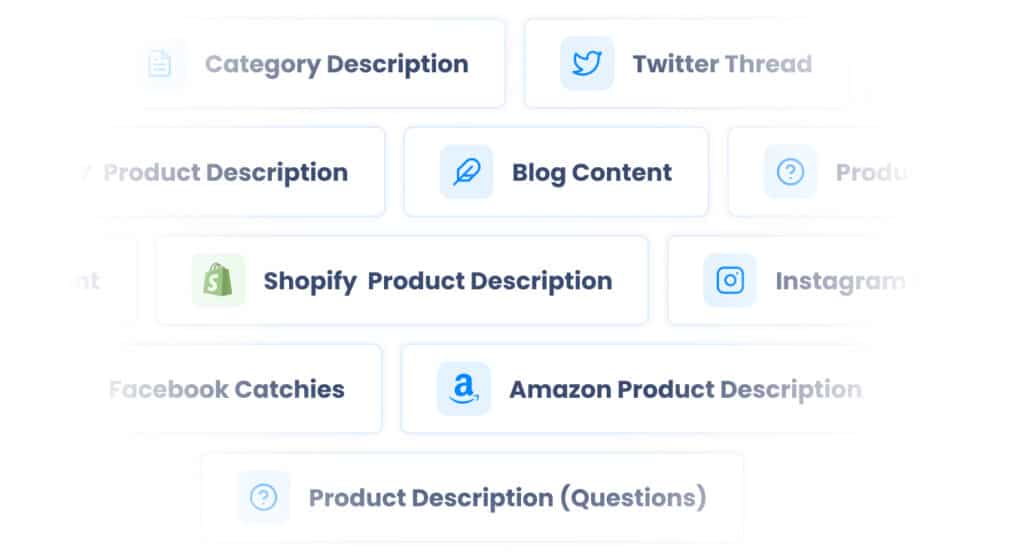
Initial Brief

Personalized Editor
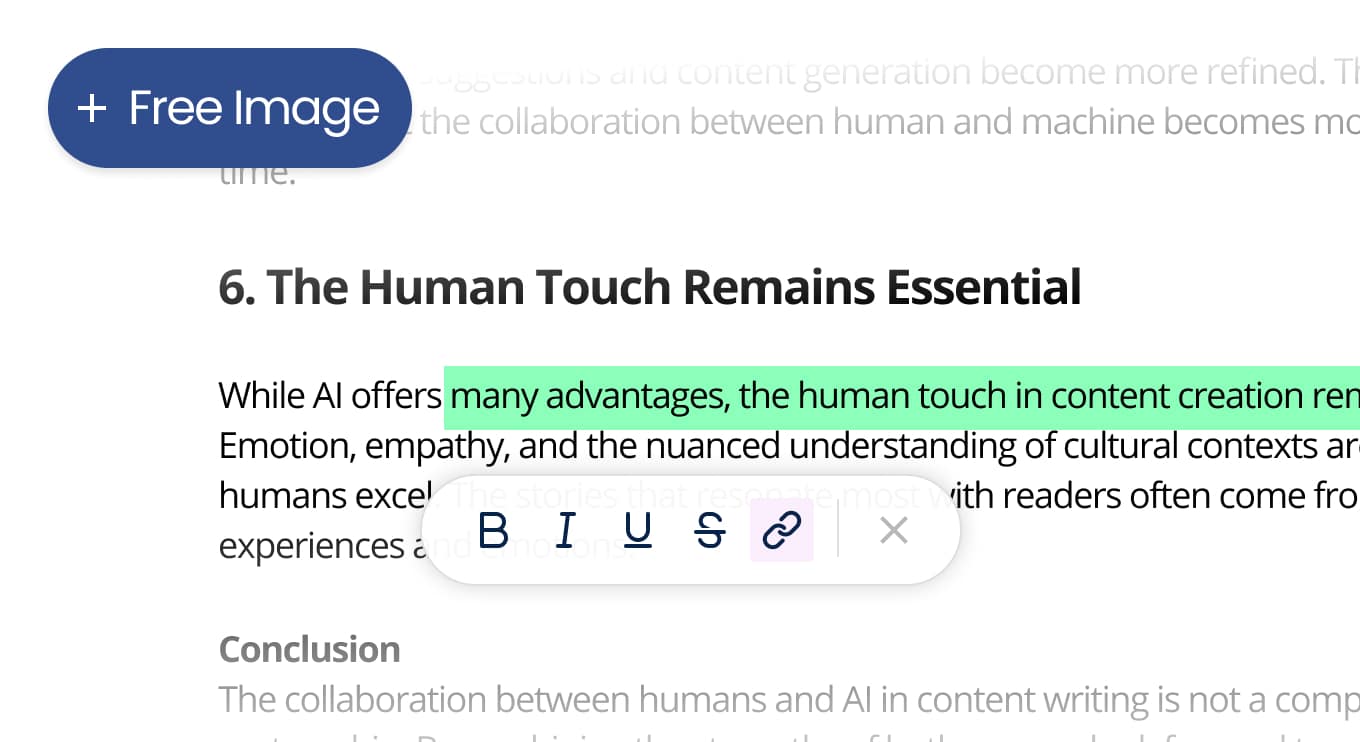
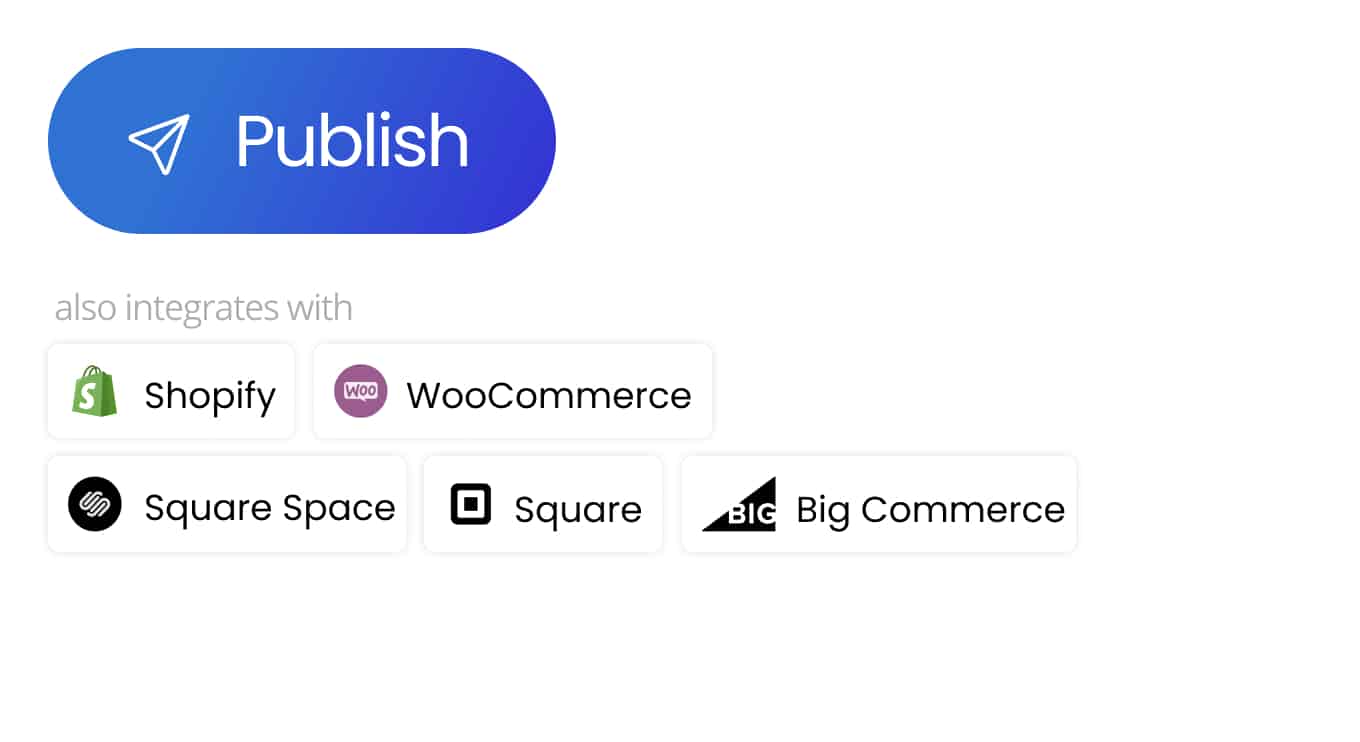
You have your content ready to be published on your website.
A Platform to 12x your Content Creation
Whether you are an aspiring freelancer, a new starter in content marketing, or an experienced SEO professional, you will be stuck here.
The platform is designed to fit everyone’s needs!

It's always a good idea to start with a template 🔥
Revolutionize your content game with our
AI-powered tool and SEO compatible templates!
Blog Post
Create targeted blog posts to convert more readers.
Shopify Product Description
Create unique product descriptions for your Shopify Store and publish them instantly.
Product Description
Request influencing product descriptions to assist shopers with their decisions.
Paragraph Composer
Request an additional paragraph to complete your text whenever you feel stuck.
X Post
Breakdown your thoughts or explain a topic to your audience with details threads.
Instagram Catchies
Connect with your Instagram audience with action oriented captions.
Use ContentGo AI to write content that ranks high and converts well!
FAQ
Some frequent questions regarding AI content!
According to the latest updates on Google Search Central, it is clearly stated that the appropriate use of AI or automation in content writing is NOT against the guidelines of Google.
Content quality plays a huge role here. Generating content mainly to manipulate the search ranking metrics is strictly forbidden and this will definitely result with spam tags on your website.
Google crawls and indexes pages including those that may contain AI-generated content.
But it would be beneficial to keep the below points in mind while utilizing AI:
- High quality content and relevance: Google always prioritizes high-quality content which is relevant to the audience that seeks that particular information. All the content that is generated with AI must meet the minimum criteria to rank well on the result pages.
- Spam filters: All the content that is mainly written to trick Google’s algorithm, lacks relevance, has no valuable information and is poorly written is not gonna perform well.
- Transparency: Google has always embraced website owners to be transparent to their audiences. All the webpages that publish AI-generated content are advised to clearly state this fact to their users. Deceptiveness or misleading information can definitely result in penalties and negatively impact your website.
- Legal Considerations: It’s always advised to the publishers or website owners to ensure that their use of AI during content generation is compatible with all the copywriting laws and regulations, and the related ethical guidelines
- Algorithms: Google updates its search engine algorithms frequently. The evaluation and ranking methods for AI-generated content may differ from time to time, so it would be beneficial to track these updates and optimize the content accordingly.
Google has confirmed that using AI to generate content won’t impact your search ranking if your content is useful, unique, and relevant.
Quality of content is more important to Google than the method used during the creation.
Google has not specified any limitations for the volume of AI-generated content. But, according to the guidelines, what matters most is the content’s quality and the precise value each content has for its readers.
The Webmaster Guidelines clearly state that all online content must be 100% unique and have high-quality and valuable information for the users. And this applies to all types of content created by a human or AI.
There are also strict regulations on automated content created automatically by different software or scripts. Even this automated content must provide value to the user and not be published to manipulate the search engines. All the content that violates these will be removed, and even the website that posts them may be penalized.
AI writing detection uses reverse engineering of language patterns to determine predictive text. This means that the computer disassembles a text and then employs algorithms to find patterns in the words. The probability that something was written by AI increases if a pattern is more evident since it is more in line with what an AI would write.
Additionally, AI writing detection is based on identifying word usage and variations. Human writing uses a creative element that cannot be simply replicated by one of these bots, whereas machines write language based on the billions of facts & patterns they were taught.
Context is vital to AI detection. Despite what would appear, machines cannot understand what words imply, yet they are pretty good at recognizing frequently used patterns. They can detect repeated words and phrases, often a red flag for automation or copy-pasting.
AI may be a great tool to increase output and boost your productivity. However, some people will abuse it just like with any new technology.
Effective AI detection techniques are not guaranteed to find all artificial intelligence-generated content. Therefore, it’s crucial to recognize it in different contexts.
1- Tone and Style of the text
AI material’s variable tone and style is one of its main problems. These models have been evaluated importantly in recent years, but they still need help creating human-like content.
All the large language models, or LLMs, deploy associations to estimate the likelihood of word placement when creating content. As a result, the output has an almost robotic sound due to its frequent linking and lack of transitional words or variable tones.
2- Accuracy
The lack of accuracy is another important warning in the content. For example, ChatGPT (the free version) was trained using data until 2021. This means that the outputs will undoubtedly be wrong if the questions are related to more recent events or information.
However, even if the update is beneficial, it is still possible to spot inaccurate output.
3- Lack of Personal Touch
Finding a lack of human opinion or feeling in the content is an accurate method to tell if it was created by an AI. Most human writers will use slang or include their own ideas. On the other hand, AI writers are more straightforward and will merely give you an answer. Usually, feelings or beliefs are absent.
4- Repetitive Words
Language repetition is another sign of AI-generated content. An article with lots of keyword stuffing is probably generated by AI-writing tools. Since prompts are used to create AI output, they frequently contain keywords. Typically, this leads to instances when one term appears repeatedly throughout the text.
5- Tools for Detecting AI Content
To help you recognize computer-generated content, you can also employ an AI content detection tool. To determine the possibility of words occurring together, they analyze text using context. The likelihood that a pattern is AI-generated increases with its predictability. AI is often less unpredictable, less creative when writing sentences, and doesn’t express opinions.
Let’s first break this down.
Although AI content has fantastic potential, some limitations still hold it back.
These consist of:
1- Quality:
AI-generated material will not be as rigorous as a competent, experienced content creator. AI chatbots continue to make mistakes and give inaccurate information, putting users in danger of misleading their audience if they publish AI content on their websites without editing and proofreading.
Additionally, AI-generated content’s language, tone, or style may be inconsistent. This might lead to content that begins in one writing style before abruptly switching to another, making the work difficult for the reader to comprehend.
Also, even when AI content is accurate, it frequently appears artificial or robotic and is typically less exciting or instructive than content created by a person. As a result, the content produced by these chatbots often still needs to catch up to the standard necessary to rank naturally.
2- Lack of Comprehension
No matter how well an AI writer can write, she needs to grasp the meaning behind her words.
As we’ve seen, AI algorithms are excellent at processing and analyzing enormous datasets. They may then utilize this information to spot meaningful patterns and trends and create their distinctive data version.
AI tools mainly cannot offer genuine insights the way a human could.
This results in repeating previously published content from various websites, acting as bright but ultimately unreliable parrots.
3- Lack of Creativity
Although AI-generated material is ‘fresh’ and ‘original’ in the sense that it has never before been published in such a fashion, there is an inherent lack of originality due to the reliance on existing bodies of work to analyze and subsequently generate content.
In the end, rather than producing original ideas, this approach is just a sophisticated, quick way of mixing existing material and presenting it in a new way.
4- Upholding the Brand’s Voice
Many businesses have acquired a particular branding style or tone of voice while growing their relationship with their audience. Recreating these distinctive traits can be challenging when relying on AI material.
While specific literary dictions and tones might be asked for by AI systems, it can be difficult to define these aspects with precise language. Accurately capturing your brand voice is also challenging due to AI content’s inconsistent tones and writing styles.
The results?
Google’s position and the restrictions mentioned above, we cannot make any precise predictions, and it would be very bizarre to support the idea that ”AI will overtake human intelligence in content writing.”.
But with the correct human input, AI-writing tools can make simple mistakes and provide accurate information, possibly violating Google’s Webmaster Guidelines.
A better question is:
How can content writers use AI to their advantage?
Content creators who can mix the unique capabilities of AI technology with a human touch will find the actual value in content creation in the future.
Human expertise can fix many of the flaws in AI content, and when used properly, there is unquestionably room for higher productivity.
Once an article is generated with an AI-writing tool, the SEO elements must be implemented to optimize the paper and make it more crawlable on search engines.
Search engines favor fresh and relevant content; generative AI can help you address this need. It can help you create content by targeting particular keywords that you provide in the input.
Also, with the correct inputs, you can involve your keywords in headers, subheadings, and meta-tags.
It’s critical to balance creativity and optimization while creating SEO-friendly content. The developed material may be made sure to be search engine optimised and easy to read.
But a human touch will be needed to make the connection even more user-friendly, ensure that users have the best possible experience, and prevent the content from seeming robotic or stuffed with keywords.
A manual touch must ensure that internal and external links are used appropriately and that the text is simple to read.
Also, as SEO titles and meta descriptions are the first impressions and the elements that make the user click on your link or ignore it – a human-based optimization is crucial to make these more persuasive for the readers.
This is a question stuck in many people’s minds.
Besides its advantages, AI has many drawbacks that must be considered while creating content.
1- Quality and Plagiarism Problems
AI mainly depends on data and algorithms while creating the content. It can be evident with opinions about different matters, but the discussion is still challenging for AI.
Remember that the outputs of AI are based on already available content, and search engines like Google may flag the new content if it possesses similarities to other published articles.
As expertise and authority are crucial according to E-E-A-T, it will be challenging to match all these criteria with purely AI-based content.
2- Strong Artificial Feel
AI lacks emotions and depth, making the outputs feel unnatural. These flows can be off-putting for readers and impact their time spent on the page, which indicates content quality.
3- A Need for Human Touch
Editing the AI-generated content is still a must.
Undoubtedly, AI saves a lot of time. However, experienced writers or editors must still be involved in the article quality review process to provide the best possible outcome to their readers.
4- AI cannot provide original and new ideas
AI tools can only generate original ideas if they rely on current data for content. Creating new material addressing the latest popular trends and themes might be challenging with these tools.
While grammatically and scientifically accurate material can be produced by AI, it cannot wholly replace human copywriting.
The ability of AI bots to write any type of content, even with a specified emphasis and topic, has been demonstrated.
An AI writer, however, cannot mix anecdotes, connect anything with human emotions, or develop a distinctive voice that personifies a brand, which is the essence of copywriting.
Even though artificial intelligence can produce different types of written content at a colossal scale, it can still not provide the originality and the touch that a human copywriter can.
There is still no algorithm that provides emotional depth and an evident personality.
People want to identify with a brand more than just read outstanding material.
